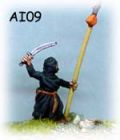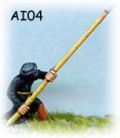Fanatic Berber
Historical Overview Section
The Murabits
The Saharan Lamtuna tribe converted to Islam in the 9th century but it was not until 1040 when one of their chiefs, Yahya ibn Ibrahim returned from the pilgrimage to Makkah (Mecca) and began spreading a more strict adherence to the dictates of the Qur'an, which in turn led to a more disciplined military organization built on a central core of infantry, armed with javelins and spears supported by camelmen and horsemen on the flanks.
From 1053, the (now named) Almoravids began to spread their religious way to the Berber areas of the Sahara and after winning over the Sanhaja Berber tribe, they quickly took control of the entire desert trade route. Under Abu-Bakr Ibn-Umar the Almoravids began to spread their power beyond the desert, and subjected the tribes of the Atlas Mountains. After a political division and reunification, Yusuf ibn Tashfin brought what is now known as Morocco, Western Sahara and Mauretania into complete subjection and by 1062 his rule extended as far east as Oran.
In 1086 Yusuf ibn Tashfin was invited by the Taifa Andalusian Muslim princes of the Iberian Peninsula to defend them against Alfonso VI, King of the Feudal Castilian Leonese or Portuguese kingdom of León and Castile. Yusuf ibn Tashfin crossed the straits to Algeciras, inflicted a severe defeat on the Christians at the Battle of az-Zallaqah (Battle of Sagrajas) but was prevented from following up his victory by trouble at home in Africa, which he had to settle in person. When he returned to Iberia in 1090, it was to depose the Taifa Andalusian Muslim princes under the auspices of a fatwa - or legal opinion - to the effect that he had good moral and religious right to dethrone the rulers who were regarded as heterodox and overly sympathetic to the Christians. By 1094 the Berbers had conquered all the Taifal Andalusian states save for Zaragoza; and although they regained little from the Christians except Valencia, Spanish Muslim power was now under central control and this checked the reconquest of the country. Yusuf ibn Tashfin assumed the title of Amir al Muslimin ("Commander of the Muslims") but died in 1106. Almoravid power was at its height at Yusuf's death, and the Moorish empire then included all North-West Africa as far as Algiers, and all of Iberia south of the Tagus, with the east coast as far as the mouth of the Ebro, and included the Balearic Islands.
Inder Yusuf's son and successor, Ali ibn Yusuf Iberia was again invaded in 1119 and 1121, but the tide had turned, the Feudal French having assisted the Feudal Navarrese and Aragonese Aragonese to recover Zaragoza. In 1138, Ali ibn Yusuf was defeated by Feudal Castilian Leonese or Portuguese Alfonso VII of León, and in the Battle of Ourique (1139), by Feudal Castilian Leonese or Portuguese Afonso I of Portugal, who thereby won his crown. Lisbon was recovered by the Portuguese in 1147.
The Almohads
Between 1130 and 1163, Berber tribes from Morocco defeated the Almoravids in northern Africa. Moorish Iberia followed the fate of Africa and in 1170 the new rulers the Almohads transferred their capital to Seville. In 1212 Muhammad III, "al-Nasir" was defeated by an alliance of the four Christian princes of the Feudal Castilian Leonese or Portuguese and Feudal Navarrese and Aragonese at the Battle of Las Navas de Tolosa in the Sierra Morena. The battle destroyed Almohad dominance. Nearly all of the Moorish dominions in Iberia were lost soon after, with the great Moorish cities of Córdoba and Seville falling to the Christians in 1236 and 1248 respectively. The Almohads continued to rule in Africa until the piecemeal loss of territory through the revolt of tribes and districts enabled their most effective enemies, the Marinids in 1215.
The Marinids
The Marinid dynasty was a Berber dynasty formed in 1244. They were largely concentrated in present-day Morocco and Spain. They overtook the Berber Almohad dynasty in controlling most of the Maghreb from the mid-1300s to the 15th century, and also supported the Kingdom of Granada, in Al-Andalus, in the 13th and 14th centuries. The last Marinid fortress in the Iberian Peninsula fell to Castile in 1344, and they were in turn replaced by the Hafsid dynasty in 1465.
Using the army in FoG
- As a mainly foot army, it may be worth having an IC to protect from shooting by mounted enemies
- With many defensive spears, the limited number of offensive spears need to be used as the cutting edge.
- Supporting archers are not that much use for the spearmen, as their benefit is only at impact and any losses will still see the spear units lose POAs due to only having one rank of spears.
UK Tournament Results with this army
Useful Links
User-contributed links about this army:
- Fanatic Berbers! DBA Figure Gallery for this army - from Fanaticus
- Fanatical Berber DBA Figure Gallery for this army - from Fanaticus
- Fanatical Berber DBA Figure Gallery for this army - from Fanaticus
- Fanatical Berbers DBA Figure Gallery for this army - from Fanaticus
- put the link text readers will see in here write some more detail about the link here
Allies
Put information on allied contingents here - including recommendations on which to use, and why.
Painting and Collecting the Army
- Paint schemes, insignia, shield designs? Put it here.
15mm Manufacturers supplying figures for this army
You can see some of the figures in the Ancients Photo Gallery also on this site. This listing only covers "arabic" figures.

|
|

|

|
- Essex Miniatures - many generic Arabs, possibly too generic for todays tastes
- Donnington - 35+ arabs
- Museum Miniatures - several nice Arab/Persian/Turkish ranges, often using the same figures in each!
- Gladiator Miniatures by Fighting 15's (Previously Black Hat) 33-strong Crusades Moslems Range
- Old Glory 15's, several Arab Ranges
- Minifigs Venerable Crusader range with Arabs
- Irregular Miniatures 39 Arab & Turk figures from a generic range
- Lancashire Games - Several large "value" packs of Arab troops
- LKM Direct - Freikorps ranges have Medieval Turks
- Tin Soldier 16 Arabs in one range
- Outpost Wargame Services A specialist in this period/region, 30+ Crusade-period Islamics
- East Riding Miniatures Some berbers in a small El Cid Range may be suitable
- Khurasan Miniatures again a specialist period for Khurasan, with several Persian/eastern ranges
- Falcon Figures Ottoman range
- Battle Line Miniatures 27 Generic Arabs
- Eureka - Australian Site Grumpys Miniatures Persian & Afghan Ranges are quite fun
- 50 Paces.com their website shows an "Arab" range, but no figure codes listed
- Viking Forge - Arab Conquest Range
- Camelot Games Italian-based supplier with 10 Arabs
- Legio Heroica 22 Crusades-era Arabs
Army Lists
Sample army lists for this army
Name of Army / Date
FANATIC BERBER 16BG
- 4x TC
- 2x8 LAMTUNA (HF/PROT/SUP/OFF SP/DRILL)
- 1x6 BLACK GUARD (HF/PROT/SUP/DEF SP/DRILL)
- 2x8 BLACK SPEARMEN (HF/PROT/AV/DEF SP/UNDRI)
- 5x4 LH (UNPRO/UNDRIL/JAV/LIGHT SP/AV)
- 2x6 LF JAV (UNP/UNDRI/JAV/LIGHT SP/AV)
- 1x6 LF SLING (UNP/UNDRIL/SLING/POOR)
- 1x4 CV (PROT/AV/UNDRIL/BOW/SWORD)
- 1x4 KN (ARM/SUP/UNDRIL/LANCE/SWORD)
- 1x4 MF CROSSBOW (UNDRIL/PROT/AV/CROSSBOW)
Remember to leave a line before you copy the above section as a template for your own list
eBay Listings
UK Bookstore
